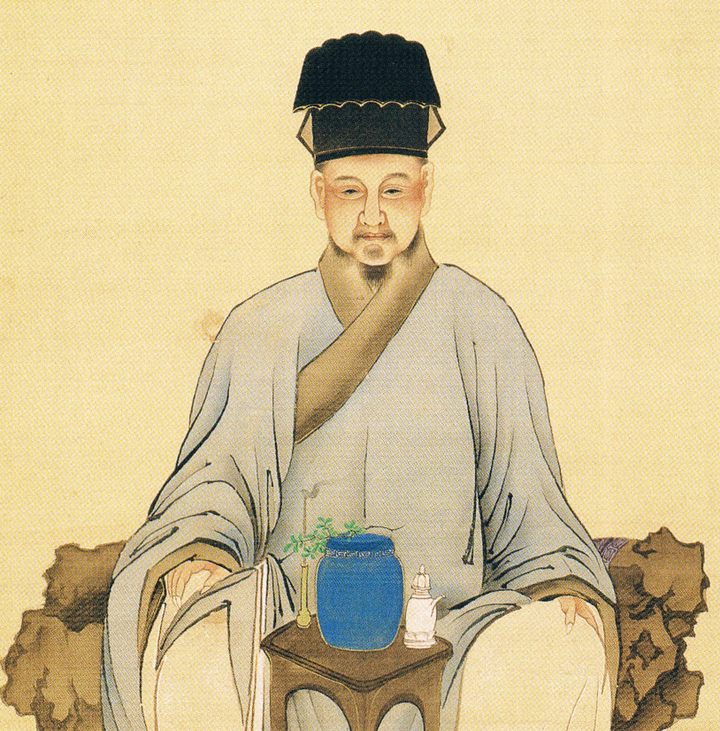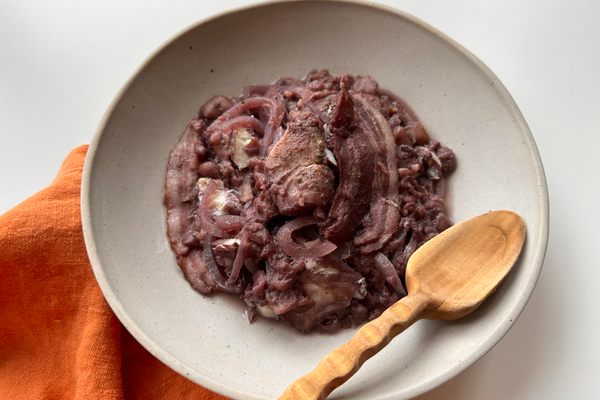

The Medieval Influencer Who Convinced the World to Drink Tea—Not Eat It
Caffeinated soups and chewing the leaves were once the norm.
Sometime in his adolescence, in the 700s, Lu Yu, an aspiring writer and professional clown, had his first taste of tea soup. This probably occurred not far from Lu’s childhood home: a Buddhist monastery that overlooked a scenic lake in Central China. But Lu was unimpressed; he called the soup “ditch water.”
What bothered Lu was not the tea, but all the other ingredients. The offending brew contained scallions, ginger, jujube dates, citrus peels, Dogwood berries, and mint, all of which cooks “threshed” together to make a smooth paste. The result was a chunky soup, or even a sauce.
Lu Yu, in fact, adored tea—he’d go on to become the “tea god” and the world’s greatest tea influencer. But the tea he loved—brewed only from powdered tea leaves, without any other flavoring—was, in the grand sweep of human history, a recent invention. People in Asia, where tea trees are native, ate tea leaves for centuries, perhaps even millennia, before ever thinking to drink it. And it is Lu Yu who is chiefly responsible for making tea drinking the norm for most people around the world.

According to George Van Driem, author of the Tale of Tea: A Comprehensive History of Tea: From Prehistoric Times to the Present Day, the ancient custom of tea-eating hailed from the forests that straddle China’s western border with Burma. Also known as the Eastern Himalayas, this lush, tropical region was the homeland of non-Chinese peoples and wild tea trees.
Thousands of years ago, the inhabitants of the forests discovered the energizing properties of tea leaves by nibbling on them raw. This spurred them to scale the tall trees, which grow more than 30 feet in the wild, and harvest the leaves. Then, at some unknown point in antiquity, they also figured out how to ferment the leaves, which they chewed like betel or added to soups and greens.
The Chinese picked up the habit of consuming tea sometime after their rulers annexed parts of the Eastern Himalayas. Before long, they were using tea to improve their concentration. For example, Hua Tuo, a legendary physician who lived in the late-second century AD, reportedly wrote, “Eating the bitter leaves is good for sharpening the mind if taken for long periods of time.”
But tea was more to the Chinese than a drug; they also saw it as a cooking ingredient. In the verdant, central coast, home chefs boiled the fresh, tender tea leaves in pots with rice and water to make a gruel. The gruel was especially popular in the sweltering summer months, as it not only stimulated the body, but also purportedly “dispelled heat.” (Many modern tea cultures similarly believe that drinking tea helps cool down the body.)

Tea foods were also ubiquitous in China’s land-locked interior. Zhang Yi, a third-century scholar, described a caffeinated soup like the one that Lu Yu despised. The locals mixed fermented tea leaves with rice paste to make a block, which they “baked until brown and pounded into powder.” For the finishing touches, they drizzled scalding water and added scallions, ginger slices, and citrus peels. The stewy and starchy offering apparently drew mixed reviews. Pi Rixiu, a ninth-century poet, complained that the tea was “muddied with other ingredients.” He also quipped that consuming it was “just like chewing boiled vegetables.”
If you are wondering why you haven’t seen tea soup on contemporary Chinese menus, you can thank Lu Yu. When Lu wasn’t performing in a comedy troupe or writing elegant treatises, he was busy scouring the forests of the Southwest in search of the best tea leaves and the perfect brew, which he made for his wealthy friends. The medieval tea lover also had a heavy hand in tea’s transformation from a soupy food into the calorie-free liquid that we know today.
Lu was not the first to infuse tea leaves or dissolve tea powder in hot water. People had been preparing tea in these ways for centuries, and tea was especially plentiful in the Buddhist monasteries of his time. Monks found the drink indispensable for fueling their marathon meditation sessions, which they often undertook on empty stomachs.
Lu probably picked up the habit of drinking straight tea from the Buddhist monk who raised him after finding the orphaned tot. (Lu would later repay his foster father’s kindness by running away from home as a teenager.) But in the 760s, Lu composed the Tea Classic, a short treatise about the production and preparation of the leaf. In it, he touted the wondrous qualities of the unadulterated beverage.
James Benn, author of Tea in China: A Cultural and Religious History, says Lu’s preference for the plain drink sprung from his conviction that the leaf was an “elixir.” Lu thought that tea’s magical properties would be dampened if mixed with more mundane ingredients such as rice. So he insisted that tea be consumed only with water and a hint of salt (to improve the water’s taste). Lu also frowned upon tea gruels or soups.

To convince readers to ditch the extra ingredients, Lu explained how to ensure a beverage that could be enjoyed on its own. For example, he stressed the importance of acquiring pure spring water and fine tea powder; using high-quality implements such as charcoal-burning stoves; and hewing to established procedures, such as whisking the powder to produce a foam top. Omitting any of these steps, Lu warned, would ruin the taste of the drink, resulting in a “weak” or “gamey” flavor. But when meticulously prepared, plain tea was sublime, “the rival of clarified butter and refined sweet dew beer,” which were then gold standards of culinary excellence.
The Tea Classic not only spurred a craze for the leaf, but it also garnered Lu great fame and inspired countless imitators. Within a half century, Lu’s mark on Chinese tea culture was evident. Tea vendors would fashion pottery statues in his likeness and worship him as their patron saint.
The runaway success of the Tea Classic reflected its author’s gift for networking. Despite his humble beginnings, Lu’s talent as a comic and penchant for self promotion won him powerful backers. While working as a clown, the 14-year-old Lu had his first lucky break. After witnessing Lu perform, a local governor declared Lu “an extraordinary talent” and adopted the boy, offering his protege a splendid education. These opportunities gave the former runaway entrée to Chinese elite society. By the time he wrote his magnum opus in the 760s, Lu counted powerful officials, Buddhist and Taoist theologians, calligraphers, and leading poets among his bosom buddies. These connections gave Lu influence over the influential.

The Tea Classic also benefited from good timing. Benn points out that Lu’s drafting of this work coincided with the An Lushan Rebellion, a mid-eighth century revolt that nearly destroyed China’s mighty Tang Dynasty (618-907). In its aftermath, the hard-partying ruling class sobered up, literally as well as figuratively. Written in a classical idiom, Lu’s Tea Classic persuaded the rich and powerful that the leaf offered a healthful and elegant alternative to wine and beer.
Lu’s treatise also convinced China’s ruling class to spurn caffeinated soups and gruels. For example, Su Che, a celebrated official and essayist, trashed spicy tea concoctions in the late-11th century. “The tea that northern hicks consume,” he scoffed, “lacks any redeeming qualities, as the salt, yogurt, ginger, and pepper overtake the mouth.”
Lu’s influence spread far beyond China. In Japan, for example, drinking an understated brew has been popular for centuries. This owes much to Japanese monks, who visited China often between the eighth and 13th centuries. Impressed with medieval Chinese tea culture, the Buddhist clerics imported tea seeds and Lu’s celebrated treatise.
Indeed, by the time Europeans encountered tea in China and Japan in the 16th and 17th centuries, it was already a foregone conclusion that tea was something to drink, rather than to chew. Samuel Pepys, the British diarist, referred to the leaf as a “China drink” in 1660. So when reports surfaced of Dutch sailors swallowing tea leaves, the news became a source of amusement. (Most likely, the sailors ate tea leaves to prevent scurvy, a common affliction on long ocean journeys.)
While many people around the world now know tea only as a drink, the inhabitants of the Eastern Himalayas continue to enjoy eating the leaves. Like their ancestors, Palaung tribespeople steam and wrap tea in banana leaves, then deposit the parcels in subterranean pits. After several months, the pickled tea leaves are ready to go into Lahpet Thoke, or the famous Burmese tea salad. The Jino, who live in Yunnan, also relish their pickled tea, and use the fresh leaves to make stir-fried greens and gruel.
Edible tea also never entirely disappeared from the Chinese-speaking world. Despite Lu’s derision, people still consume a tea stew called leicha (擂茶). Translated into English as “pounded tea” or “thunder tea,” leicha is best known as a distinctive food of the Hakka, a group of Han Chinese who fled a war-torn North China and settled in the South many centuries ago.

Although every Hakka cook puts their own spin on the recipe, the basic outlines are similar. Start by making a paste. Mortar the green or Oolong tea with ingredients, such as scallions, ginger, mint, sesame seeds, and basil, then add hot water. Once you have a bright, green sauce, pour it over a bed of rice and your choice of vegetables and bean curd.
In recent years, this caffeinated stew has witnessed a minor revival thanks to the popularity of Hakka cuisine. Pounded tea is now a beloved street food in Malaysia and an ice-cream flavor in Taiwan.
Foodies also no longer dismiss pounded tea as “ditch water.” In The Hakka Cookbook: Chinese Soul Food from Around the World, Linda Lau Anusasananan extols its uniqueness: “Each element of the topping contributes a different taste and texture,” she writes. The sauce is “smooth, creamy, and herbaceous. When combined with the garlic-scented rice, the dish satisfies and energizes.”
While it is unclear whether pounded tea will ever become a mainstream food again in China, one thing is certain: From Himalayan tradition to scorned country food to acclaimed heritage, eating your tea has come full circle.
Leicha (Herbaceous Pounded Tea from Malaysia)
From The Hakka Cookbook Blog, by Linda Lau Anusasananan
Makes about 5 1/2 cups, 6 to 8 servings, of tea to serve over rice and greens
Ingredients
2 cups fresh Thai or Italian basil leaves
2 cups fresh mint leaves
2 teaspoons vegetable oil
1 teaspoon chopped garlic
1/4 cup chopped cilantro
2 tablespoons dried green tea leaves
6 black peppercorns
2/3 cup roasted salted peanuts
3 tablespoons toasted sesame seeds
1 cup cold water
4 cups boiling water
1 teaspoon kosher salt, or to taste
- Coarsely chop basil and mint. Set a 10- to 12-inch frying pan over medium-high heat. When the pan is hot, add the oil and rotate the pan to spread. Add the garlic and stir until soft, about 30 seconds. Add the basil, mint and cilantro; stir-fry just until the herbs turn bright green, about 30 seconds. Remove herbs from the pan.
- In a blender, finely grind the tea leaves and peppercorns. Add the peanuts and sesame seeds; blend until finely ground. Add the basil mixture and cold water, and blend until smooth.
- Just before serving, add 1 cup of the boiling water to herb mixture in blender and whirl until smooth, holding blender lid down with a towel. Pour tea into a 2-quart pan. Add the remaining 3 cups boiling water and salt; whisk until blended. Stir over medium heat until hot. Serve hot.
Author’s note: This recipe is very similar to the soup that Lu Yu complained about. For my part, I enjoyed it. This is just the tea portion of the recipe, you should pour it over rice topped with stir-fried greens and pressed tofu. Anusasananan has a recipe with suggested toppings and garlic rice on page 120 of The Hakka Cookbook.
When I cooked this leicha recipe, I cooked 1 cup of rice, sauteed a head of bok choy until it wilted slightly, and fried slices of pressed tofu in the wok. To serve, I put a half cup of the cooked rice into a bowl, added the bok choy, pressed tofu, roasted peanuts, and preserved mustard greens, then drizzled the tea sauce on top. You can add more tea sauce if you like your food soupier, and season it with additional salt and pepper. Though not traditional, I found that a pinch of spicy, fermented Burmese tea leaves, which I bought from Amazon, enhances the flavor.
Gastro Obscura covers the world’s most wondrous food and drink.
Sign up for our regular newsletter.
































Follow us on Twitter to get the latest on the world's hidden wonders.
Like us on Facebook to get the latest on the world's hidden wonders.
Follow us on Twitter Like us on Facebook